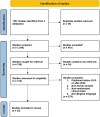A Systematic Review of Digital Ophthalmoscopes in Medicine
- PMID: 37822326
- PMCID: PMC10563770
- DOI: 10.2147/OPTH.S423845
A Systematic Review of Digital Ophthalmoscopes in Medicine
Abstract
Purpose: Recent advances in telemedicine have led to increased use of digital ophthalmoscopes (DO) in clinical settings. This review aims to assess commercially available DOs, including smartphone (SP), desktop, and handheld ophthalmoscopes, and evaluate their applications.
Methods: A literature review was performed by searching PubMed (pubmed.ncbi.nlm.nih.gov), Web of Science (webofknowledge.com), and Science Direct (sciencedirect.com). All English-language papers that resulted from the search terms "digital ophthalmoscope", "screening tool", "glaucoma screening", "diabetic retinopathy screening", "cataract screening", and "papilledema screening" were reviewed. Studies that contained randomized clinical trials with human participants between January 2010 and December 2020 were included. The Risk of Bias in Systematic Reviews (ROBIS) tool was used to assess the methodological quality of each included paper.
Results: Of the 1307 studies identified, 35 met inclusion and exclusion criteria. The ROBIS tool determined that 29/35 studies (82.8%) had a low risk of bias, 3/35 (8.5%) had a moderate risk of bias, and 3/35 (8.5%) had a high risk of bias.
Conclusion: The continued adoption of DOs remains uncertain because of concerns about the image quality for non-mydriatic eyes and the confidence in data captured from the device. Likewise, there is a lack of guidelines for the use of DOs, which makes it difficult for providers to determine the best device for their practice and to ensure appropriate use. Even so, DOs continue to gain acceptance as technology and practice integration improve, especially in underserved areas with limited access to ophthalmologists.
Keywords: diagnostics; fundoscopy; referral; screening; teleophthalmology.
© 2023 Robles et al.
Conflict of interest statement
The authors declare that they have no conflicts of interest in this work.
Figures


References
-
- American Academy of Ophthalmology. Undiagnosed Glaucoma — a pressing U.S. Problem; 2019. Available from: https://www.aao.org/eyenet/academy-live/detail/undiagnosed-glaucoma-pres.... Accessed May 11, 2022.
Publication types
LinkOut - more resources
Full Text Sources
Miscellaneous

